Archive for Places to go
October 13, 2007 at 3:58 pm · Filed under Places to go
 This is the farthest we’ve ever taken this Airstream north ( 51 °11’0.62″N). In mid-October at this latitude, our solar panels still generate some power, but not nearly enough to compensate for the furnace. Nights are running in the low 30s and daytime highs are in the 50s, with the sun passing by at a very low angle. This is optimal weather for October but without a power hookup for the Airstream we’d still lose ground rapidly.
This is the farthest we’ve ever taken this Airstream north ( 51 °11’0.62″N). In mid-October at this latitude, our solar panels still generate some power, but not nearly enough to compensate for the furnace. Nights are running in the low 30s and daytime highs are in the 50s, with the sun passing by at a very low angle. This is optimal weather for October but without a power hookup for the Airstream we’d still lose ground rapidly.
I ordered a catalytic heater from Vintage Trailer Supply last week. I don’t foresee us having it installed in time to use this winter, but it will be a welcome upgrade later.
Fortunately, this campground (Tunnel Mountain) has 30 amp electric hookups. That’s all we need to stay until our water runs out, which based on our Yellowstone experience could easily be more than a week. In this case, however, weather and work will be the limiting factors. The weather is forecast to turn gloomy on Wednesday and I’ll need to find better access to the Internet than the expensive “cybercafes” in downtown Banff and Lake Louise. That means we’ll be heading southwest through British Columbia, into Washington state by Tuesday.
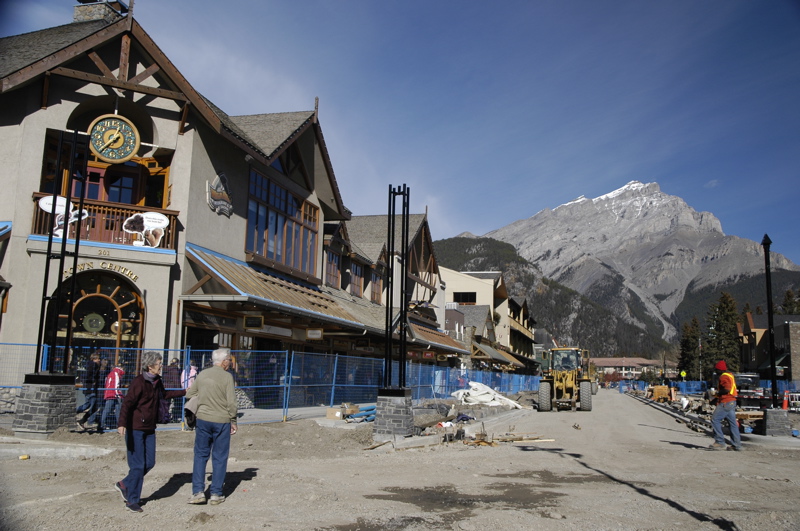 This time of year the options of “what to do” in Banff are more limited than in Summer. All of the campgrounds are closed except the one we’re in. The amphitheater talks are done for the season. Open hours are limited in many places, the “Ice Explorer” (a sort of giant bus than takes tourists over the glacier) stops running on the 15th, some roads and historic sites are closed, etc.
This time of year the options of “what to do” in Banff are more limited than in Summer. All of the campgrounds are closed except the one we’re in. The amphitheater talks are done for the season. Open hours are limited in many places, the “Ice Explorer” (a sort of giant bus than takes tourists over the glacier) stops running on the 15th, some roads and historic sites are closed, etc.
So we decided to stay close to home today and explore the town of Banff. Eleanor was completely charmed by it. It’s a small town with a touristy center (the main street is currently under reconstruction), but throughout there is interesting architecture, historic homes, walking trails, and a general friendly walkability that makes exploring on foot a pleasure. Everywhere you look, there is a view framed by the towering mountains, which catch the sunlight in all sorts of interesting ways.
Everything in Banff is expensive, which is probably why I noticed a lot of younger tourists eating slices of pizza on the street rather than going inside the cafes and restaurants. I checked a lot of streetside lunch menus: a burrito was $14, a “hamburger special” was $10, egg foo yung was $14, and fondue for one was more expensive than a lobster in Maine ($34).
But you don’t come here to save money. You come here because it is just spectacular to see. Along the drive through Kootenay last, we spotted a handsome black bear snuffling around in a meadow, gorging itself ( “hyperphagia”) in preparation for hibernation. Elk are a common sight right now, too. We saw a pair of huge bull elk walking through a residential neighborhood up the hill. From our windows in the Airstream we can see just incredible mountains and glacially-carved ridges which seem to change with every passing minute.

One of my interests is the former Canadian Pacific Railway hotels, which are found in almost every major Canadian city. (Now they are part of the Fairmont luxury hotel chain.) I like to go see them just because they are such marvelous examples of architecture, and romantic symbols of the railway era. The Banff Springs Hotel is one of the most famous, but there’s also the Chateau Frontenac in Quebec City, the Queen Elizabeth in Montreal, the Royal York in Toronto, and the Chateau Laurier in Ottawa. We’ve stayed at all of those. Just about 60 km north of here there’s the Chateau Lake Louise, which we will most definitely go see tomorrow.
The mountains in this area are almost indescribably spectacular, yet somehow familiar. Both Eleanor and I puzzled about this for a few minutes in the morning while watching the sun come up and illuminate the high peak, before coming to the same conclusion. This area is the only place we’ve ever seen in North America that looks like Yosemite National Park. The rugged stone and dramatic elevation changes are reminiscent of the area near Half Dome, except that here the view is 360 degrees around us at all times.
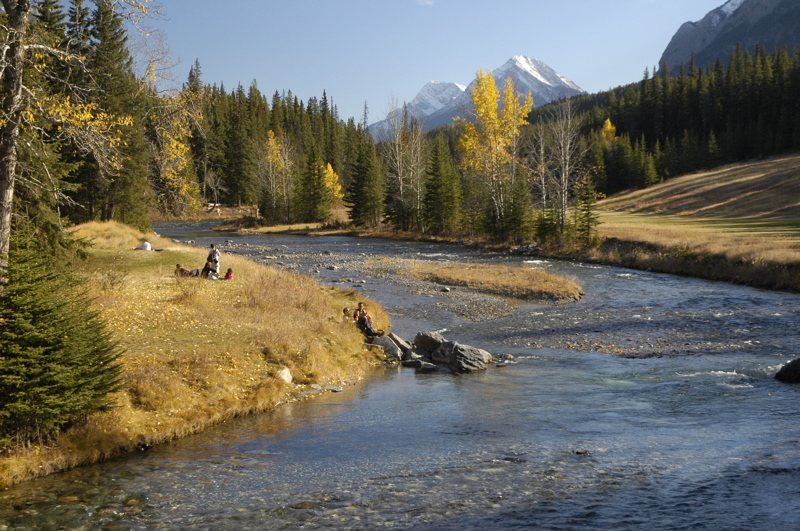 You could easily spend a day just looking at the views. They are endless and constantly changing. Every street in town, every site in the campground, every minute of the day, has a different view ““ and they are all good.
You could easily spend a day just looking at the views. They are endless and constantly changing. Every street in town, every site in the campground, every minute of the day, has a different view ““ and they are all good.
One of our stops in town was Keller’s grocery, where Bles-Wold yogurt is sold. That’s the yogurt that Bill from Alberta has been recommending to me (not sold in the US). Sadly, Keller’s didn’t have any plain yogurt in stock, but I bought a quart of strawberry just so I could try it out. Bles-Wold is very creamy with a buttery flavor and I liked it. It contains no additives, so it passes the purity test. Too bad I can’t get it in the USA.
Our other little grocery purchases were several pastys for dinner, and a half-dozen interesting-looking Canadian candy bars just for fun. I snagged a Cadbury Wonderbar and a Coffee Crisp, which are two of my faves from Canada. Airstream Life is printed in Canada and our printer sends us a gift bag of candy every year, which has probably been the cause of this particular fetish.
Being this far north in the fall, and surrounded by mountain ridges, sunset comes early. By 6:30 the light was waning, with a final gorgeous golden display to be seen from the campground. This made us think about our next destination. If it were summer, we’d be tempted to head north even further, eventually to Alaska, but now we have no choice but to point the Airstream west to the temperate Pacific coast. There, freezing and snow will be much less likely, and we can spend months slowly working our way south if we want to.
There is one major barrier between us and the Pacific: the Cascade Mountains. The only low pass through that range that I know of is along I-84. There, the highway follows the Columbia River Gorge. It’s a really nice drive (which we did in July 2005) but it is so far south that it would cause us to miss nearly all of Washington state.
Our preferred route is through British Columbia to Vancouver, or failing that, through northern Washington state to Seattle. But both of those routes will bring us over the Cascades, and if there’s any snow we will be forced to backtrack hundreds of miles to find an alternate route. So we’ve worked out several scenarios for getting west, and we’ll pick the one that looks the best based on the weather in the next week.
October 10, 2007 at 8:44 pm · Filed under Places to go
I wish I had a photo of Moose’s. Not the large antlered animals, but the restaurant/bar in downtown Kalispell. But my first pictures of Moose’s Saloon, from our visit last summer, disappeared in “the hard drive crash of ’06“, and this evening I simply forgot to take out my camera.
After a long day at the laptop, a day in which absolutely nothing of note happened, it was great to head up to Kalispell for dinner at Moose’s with Eleanor, Emma, Bert and Janie. That’s because a place like Moose’s is a simple pleasure. It’s a place where you can throw your peanut shells on the sawdust-covered floor. A place where the pizza is just fine, and the topping list is limited to the familiar basics — no shrimp, spinach, or chocolate shavings.
At Moose’s you are apparently allowed (perhaps even encouraged) to crave your name on the wall and on the booth, because it has been done so much that not an inch of the place remains pristine. The plates are basic Boy Scout camp-ware, flat aluminum and slightly dented. The drinking glasses are cold and heavy goblets, so thick at the lip that you can barely drink from them.
A square bar makes up half of Moose’s and a dozen or so tall booths of dark wood are the other half. Waitress service is limited to someone delivering your pizza (after you order it at a stand-up window) and picking up the remains. It’s not a place where someone tucks in your bib or even offers little moist towelettes. But it is a place to hang with your good friends over a couple of 15” pizzas and share a pitcher.
It’s also not a photogenic place. From the outside Moose’s is a flat storefront without even an interesting neon sign to beckon you in. From the inside, it’s sleazy-dive dark (but refreshingly free of smoke). It would be a photographic challenge to get a picture that really represented the atmosphere.
If I hadn’t been so busy talking and eating pizza, I might even have remembered to break out my camera and tripod. Maybe I would have gotten a picture for the blog. But that’s what happens at Moose’s. It’s too easy to relax in there.
October 8, 2007 at 8:08 pm · Filed under Places to go
One of the great things about traveling with Bert & Janie is that they bring us to places we’d be unlikely to visit otherwise. Case in point: Bannack, Montana. It’s so far off the beaten path and not on the way to much that we probably would have passed it by.
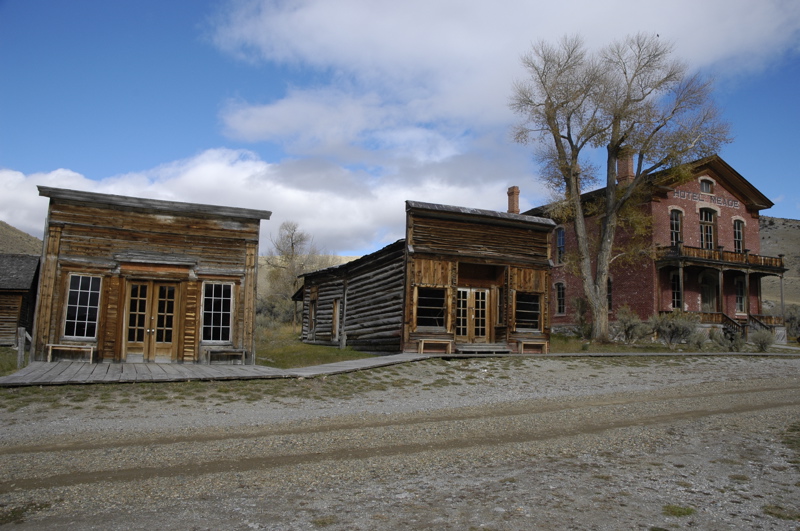
Bannack is a ghost town, the best I’ve ever seen. Once a gold rush town and the territorial capital of Montana, it has managed to escape becoming either a tourist trap like Tombstone AZ or a collection of dried-up ruins like so many Nevada settlements. The state made it a state park and thus Bannack is preserved and free from commercial inflammation.
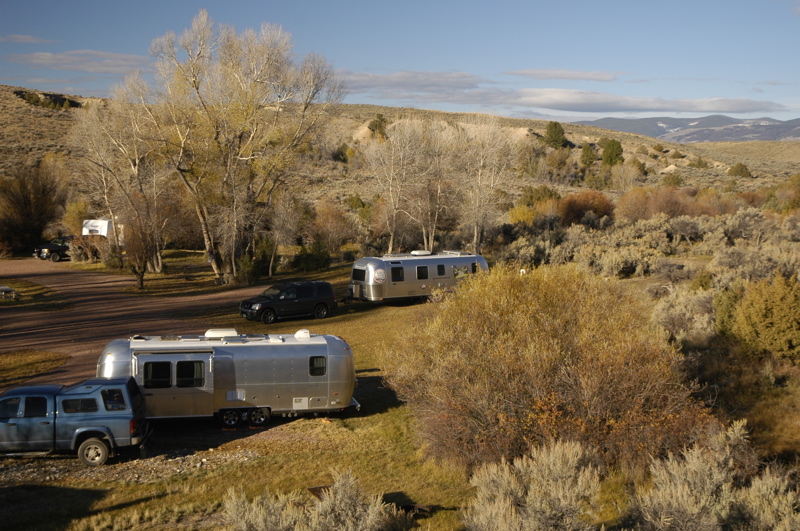
For RV’ers, Bannack is an excellent stop because there are two small and tranquil state park campgrounds a short 1/4 mile walk from the townsite. These campgrounds are small, and border Grasshopper Creek (more on that in a moment). The sites are grassy and open, occasionally shaded by cottonwood trees, and have a expansive view of the surrounding mountains. There are no hookups, no cell phone service, no amenities of any kind, and no dump station, but for $10 ($6 for Montana seniors) it’s well worth a stay.
WordPress (the new blog software we’re using now) does not allow me to upload the Google Earth placemarks that I used to insert into the blog from time to time. But here’s the Lat/Long for the campground we visited in Bannack State Park: 45 ° 9’54.12″N, 113 ° 0’16.66″W. You can plug that into Google Earth (or any other mapping program) and see the location. The ghost town is just east of the campground.
Two days before in Virginia City I bought a book by Dorothy M Johnson called “The Bloody Bozeman.” It’s about the creation and history of the Bozeman Trail. The book starts in the historical epicenter of Montana in 1862 — Bannack — and describes not only the gold rush that started on the banks of the Grasshopper Creek and resulted in the founding of Bannack, but the surrounding stories of battles with the Sioux Indians, survival in the western wilderness, and the marauding “Road Agents” who operated between Bannack and Virginia City.
There’s nothing like reading these tales while I’m camped in the exact spot where they happened. It’s spooky enough to walk through the open dirt street of Bannack and look at all the empty buildings … but quite a bit spookier to have the stories of John Bozeman and Red Bear, Jim Bridger and “Clubfoot” George Ives fresh in my mind as I see the land where they once rode, shot, and died.
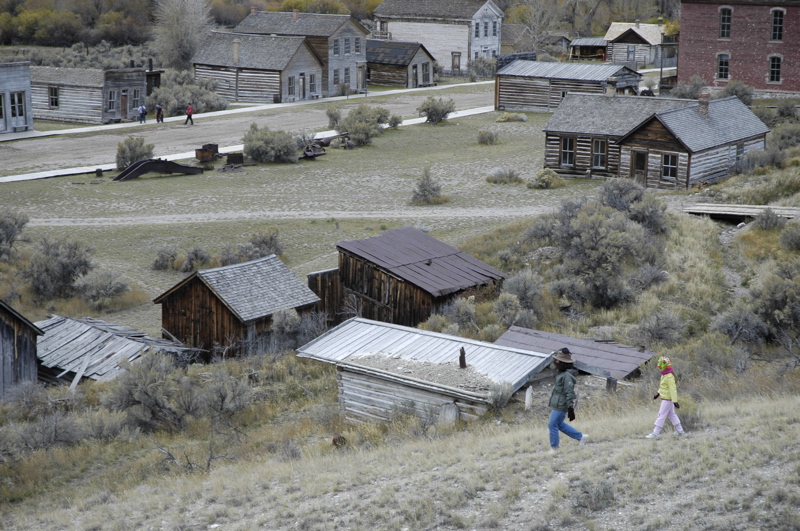
Up the hill from town is the gallows. It’s not much to see — a simple arrangement of poles, like field goal. But on the short hike up, you can imagine you’re going up to witness the hanging of Henry Plummer, leader of a gang of road agents, who said when finally caught and arrested that he was “too evil to die.” On the gallows high on the hill above Bannack, Plummer asked for one last favor: “Give me a good drop” so that he would die quickly.
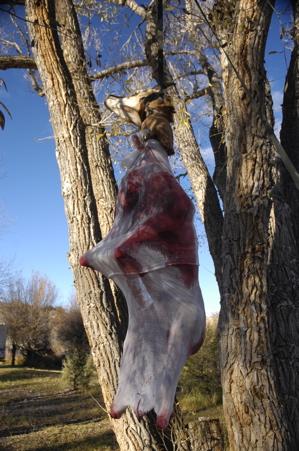
This is antelope season. Although hunting isn’t allowed in the state park, many of our neighbors in the campground seem to be hunters who use the park as a base of operations. In the evening the results of one successful hunt were seen swinging from a tree next to our campsite … an eery reminder of the men who swung from the gallows just a quarter-mile away.
In the evening Emma challenged Bert to a game of checkers. No slouch at checkers or chess, Bert gave her a run for her money and eventually defeated her. I think perhaps my threat to mention in the blog that he was beaten by a 7-year-old put him on his best game. Then Emma challenged me and beat me handily due to my failure to see two double-jumps coming.
Tonight we are on our own up, about 90 minutes north, near Butte. Bert & Janie have gone on ahead to their home in northern Montana, and we’ve stopped at Fairmont Hot Springs Resort to have a swim in their hot water pools. The resort has giant indoor and outdoor pools (two each, running 92-94 and 102-104 degrees), and a huge five-story tall water slide. After all the cold weather we’ve seen lately, this seemed like the right stop to make.
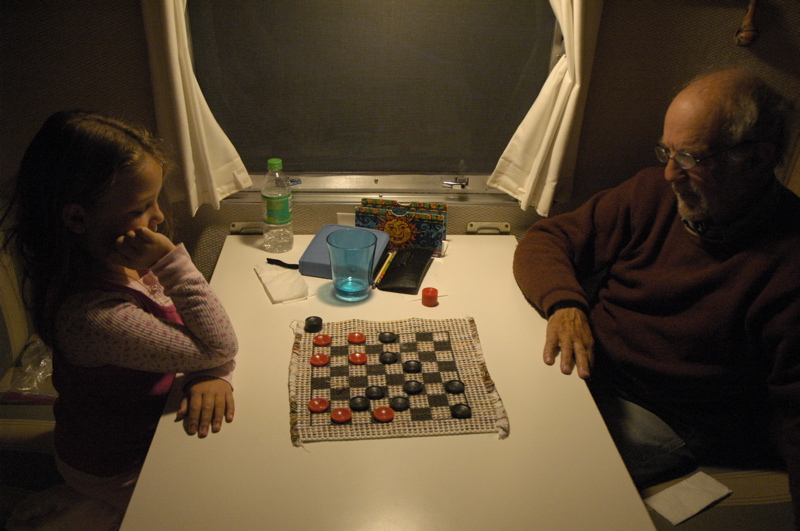
Fairmont Hot Springs RV Resort: 46 ° 2’31.89″N, 112 °48’23.77″W.
October 5, 2007 at 7:14 pm · Filed under Places to go
For the next few days we’ll be following Bert & Janie as they research a few spots in Montana for articles they are working on. One of the articles is actually for Airstream Life magazine’s Summer 2008 issue, about things to see and do in Montana. I’m kind of shooting photos over Bert’s shoulder, in hopes of spotting a sidebar I can write to go with his article.
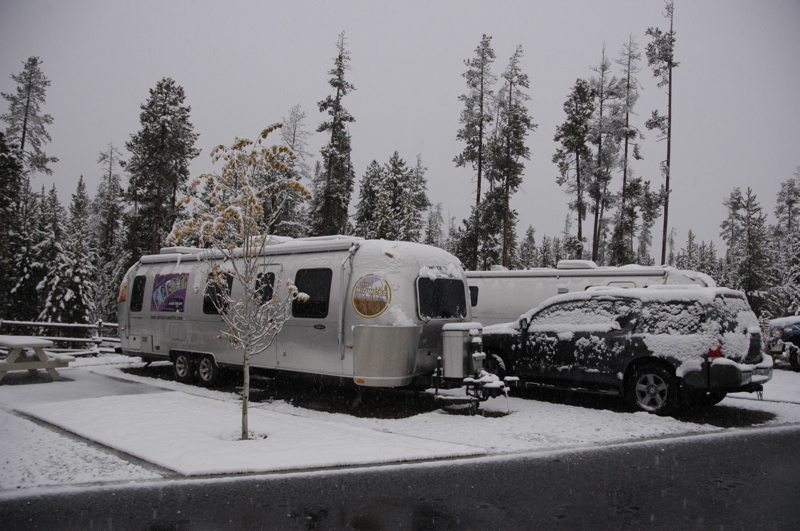
Morning in West Yellowstone, MT
As predicted, the rain last night turned to snow, and we woke up to about two inches of very wet snow. It makes great scenery and Emma loves it, but it also makes the process of breaking camp a lot slower. I keep a junky beach towel in the back of the Armada just for wiping stuff clean, and the towel got used a lot this morning to dry off things like the power cord.
With all the cold weather and snow I have to remind myself that it’s just early October. It seems like December in Vermont. The ride up into the mountains on Rt 87 and Rt 287 from West Yellowstone was stunningly beautiful at times, especially near Quake Lake, but it was just as nice to descend a little down to the relatively low town of Ennis MT and see the snow deliquesce into light rain and green grass. I would have been much more nervous about this drive if the roads were frozen, but it’s still early enough in the season that ice on the roadways is unlikely.
We are using Ennis as a base camp for the next two nights, while we make explorations into the nearby famous western town of Virginia City. (Virginia City does have a good RV park but there’s no cell phone service there and I wanted to be in touch over the weekend.) It’s 14 miles up and over some mountains to find Virginia City and the historic remains of Nevada City as well.
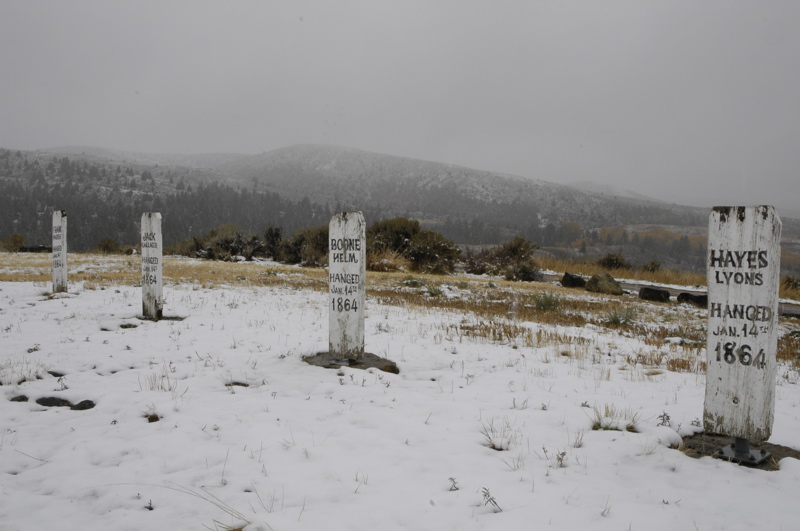
Boot Hill, resting place of several “road agents”
Virginia City is a true western town, perhaps the quintessential western town, and it is loaded with good examples of preserved architecture and lots of gory history. The museum, for example, includes the foot of “Clubfoot” George, but I’ll talk about that tomorrow when we go see it. Tons of westerns have been filmed in Virginia City or the nearby remains of Nevada City. There’s an amazing amount of preserved history here and it’s all fun to discover.
With the weather still fairly lousy today (light rain & snow, fog), we decided to save the intense browsing of Virginia City for Saturday. We found an old pub in town and settled in for a long lunch and some conversation with the proprietors.
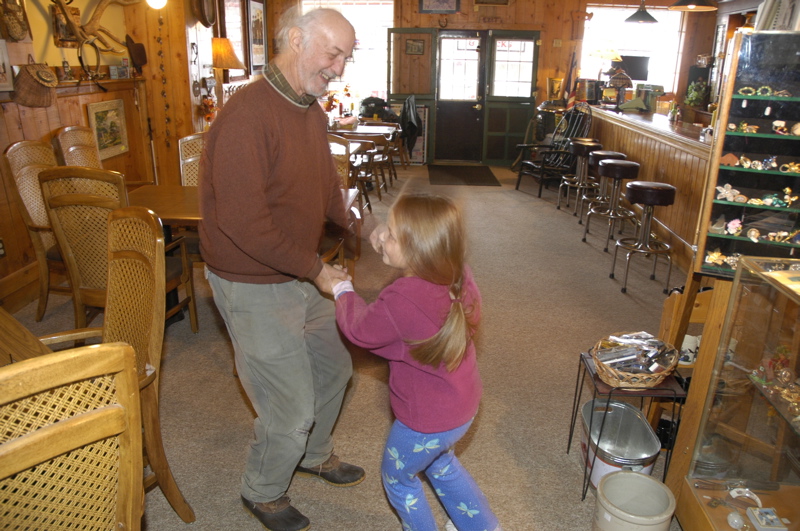
Inside they were playing old big band favorites, and at one point Bert invited Emma to dance. Since we were the only customers all afternoon, the management didn’t mind our tourist antics.
Nevada City, just a mile or two down the road, is really not a town at all anymore. There were about eight original buildings remaining in the 1940s, but then others were collected from all over Montana to create a preservation site of old western rustic architecture. Now there are dozens of buildings assembled into a sort of museum, which you can tour for about eight bucks. This time of year, of course, the place is closed but there’s still a lot to be seen from the street.
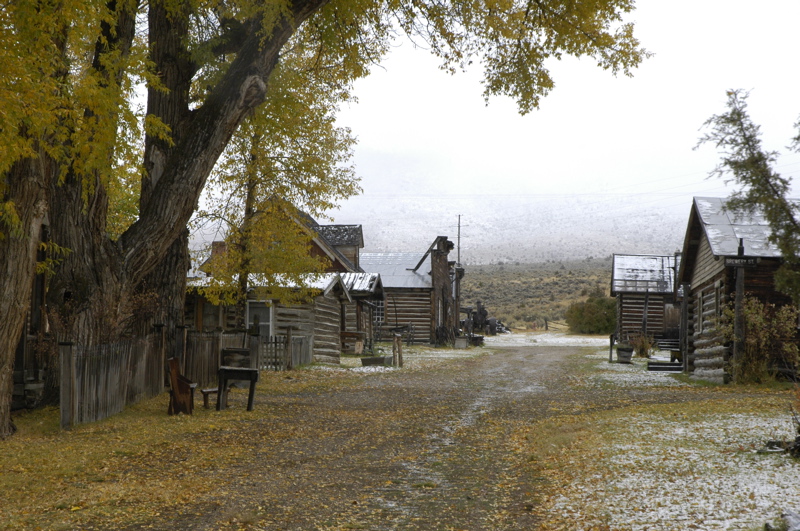
Nevada City, MT
We’ll be touring ghost towns and preserved gold mining towns for the next few days. I’m also working on plans for a visit to Banff, Alberta. The weather in Banff is potentially tricky but this time of year we have a chance of being able to get up there, as long as we watch for snowstorms. Our arrival there is still a week away, so we’ll keep an eye on things and see if it remains a possibility.
October 1, 2007 at 8:35 pm · Filed under Places to go
22 degrees at 8:00 a.m. / -107 amp-hours cumulative (40 amp-hours used overnight)
We would be leaving the park today but we’ve booked another night. The weather has turned colder now, and we’re expecting some snow overnight. It is starting to feel like winter up here at 7000 feet. Hard to believe it’s just the first day of October. But even though we are over a hundred amp-hours into our battery bank, we still have conservatively 50 more amp-hours to burn before we start to get into our emergency power reserve.
Eric and Sue, being official travel writers, as are Bert & Janie, have obtained a complimentary admission for all of us to the Grizzly and Wolf Discovery Center in West Yellowstone. That’s just 14 miles from Madison campground, in the little outpost town at the west entrance of the park.
Since I haven’t seen a grizzly in the wild yet (and perhaps I would rather not), this seemed to be the ideal way to observe them up close and get some good photos. That’s what the travel writers were all hoping for too. Bert is working on an article for a competitor RV magazine and Eric and Sue are working on something as well. All of them need photos of wild creatures to illustrate their writings.
(By the way, traveling with travel writers is the way to go. Every day I am getting amazing tips on places to go and things to do in the northwest. You’ll see some of their tips appearing in our travels in the next few months.)
 The Grizzly and Wolf Discovery Center is a not a roadside zoo, but a non-profit organization that works with Yellowstone rangers, makers of bear-related products, and other conservation organizations for the protection of wild animals. It’s a great place to stop on your way in or out of Yellowstone National Park’s west entrance. There’s a good visitor center and outside there are habitats with grizzly bears and wolves. The admission is good for two days, so Eleanor and Emma may go back tomorrow.
The Grizzly and Wolf Discovery Center is a not a roadside zoo, but a non-profit organization that works with Yellowstone rangers, makers of bear-related products, and other conservation organizations for the protection of wild animals. It’s a great place to stop on your way in or out of Yellowstone National Park’s west entrance. There’s a good visitor center and outside there are habitats with grizzly bears and wolves. The admission is good for two days, so Eleanor and Emma may go back tomorrow.
In the photo, you can see why hanging a bird feeder is not a good idea in bear country. This 1,000-lb male is about to knock this dead tree over in order to get a snack of birdseed. It took him less than a minute to uproot it. Several times a day, the Center puts different bears into the public habitat with hidden snacks, and you can watch as the bears instantly detect the food using only their nose and casually toss aside boulders and stumps to uncover it. It’s absolutely amazing to see how powerful these creatures are. Heck, just a look at their huge front claws is enough to make you never want to encounter a grizzly bear in the wild.
All of the bears here would have been killed if they hadn’t been moved here. They were mostly bears that had become habituated to humans and were raiding trash or killing farm animals. Coming to the Center was their reprieve from being destroyed. As they say, “A fed bear is a dead bear.” Please don’t feed the animals!

We got a guided tour from John, who showed us an exhibit of “bear-proof” trash containers they’ve tested. Testing is easy: just put some food in the container and leave it in the bear habitat. It’s just like those old Samsonite luggage commercials where they put the suitcase in a cage with an ape. Most containers fail the test. It’s humbling to see what the bears can do.


The Center also has a nice exhibit with wolves, and several raptors that for various reasons can’t be returned to the wild. I can’t do justice to it all in a single blog entry, so I’ll just say that the place is worth the price of admission.
Since were in West Yellowstone, where cell phones work, I downloaded 475 emails (377 of which were spam or useless) and resigned myself to going back to work on Tuesday. We picked up a frozen pizza at the local supermarket for dinner and since it was our last night in the park, I decided to splurge on the power budget and watch a DVD on the laptop.
Our solar gain report for the day:
Mostly cloudy. At 4:30 p.m. cumulative amp-hours were -83. 24 amp-hours gained.
September 28, 2007 at 7:23 pm · Filed under Places to go
29 degrees at 8:30 a.m. / -71 amp-hours cumulative (43 amp-hours used overnight)
This morning I followed Bert and Janie on our first photo expedition. Our goal was elk but we didn’t spot any for hours. We did see a lot of bison, which are everywhere. Here, a bull bison is using his tongue to help sniff the air for eligible females. The bison rutting season was earlier this summer, but he holds out some hope for a late bloomer.
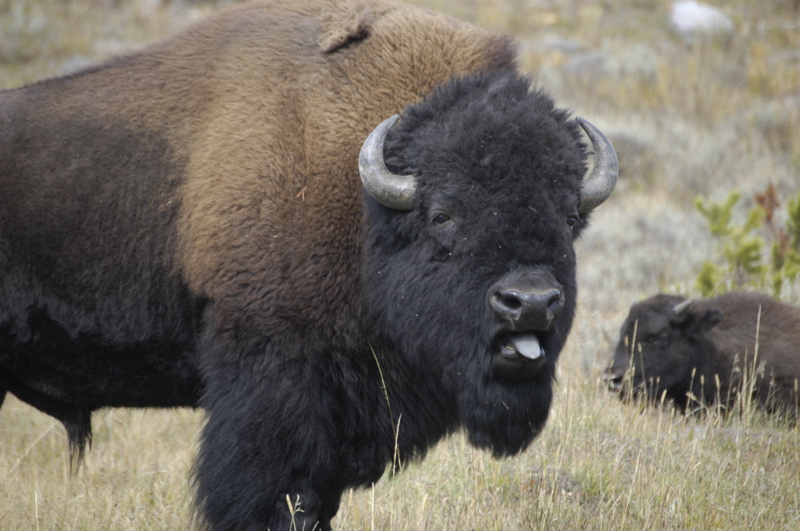
I followed Bert and Janie as far as Hayden Valley and then headed back to camp to take Eleanor out to see a few sights. Emma was deeply enthralled by her new friends and would have preferred to just stay at camp.
Of course, less than a mile from the campground (in the opposite direction we’d gone in the morning) we found a herd of elk calmly munching grass and moss and posing for pictures. This female elk is sporting a popular piece of elk fashion, a radio collar. Quite a bit of research goes on in this park.
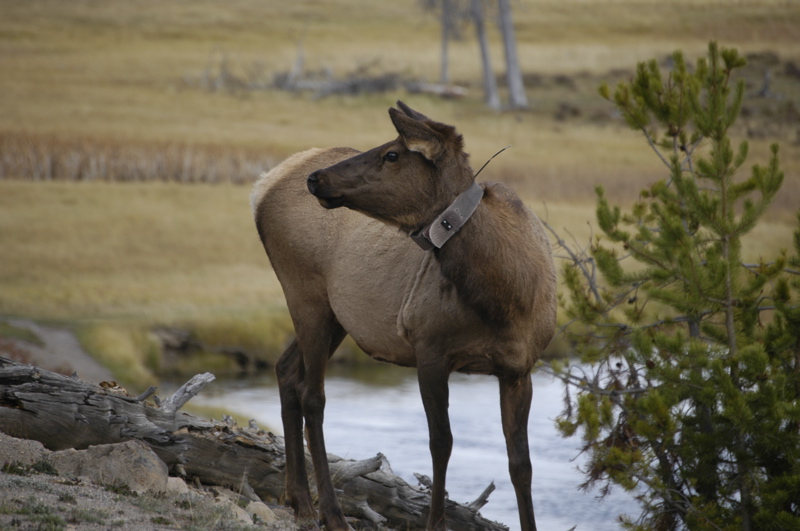
I have been reading a book entitled “High Endeavours: The Extraordinary Life and Adventures of Miles and Beryl Smeeton”. This very honest biography seems a good companion to our traveling life. Miles and Beryl were incredible thrill-seekers and travelers. I can’t do justice to the stories of their travels, so I’ll just say that this is one I can recommend if you want an inspirational look into the minds of a pair of serious travel junkies. Their travels ranged from Beryl’s 500-mile solo walk through the jungles of Burma and Siam during the monsoon, to several round-the-world sailings in their 46-foot yacht. The book is probably out of print but I found a copy through Alibris.
In order to avoid having to hitch up and tow the Airstream to the dump station, we are on extreme water conservation tactics. We are using the campground bathrooms most of the time (which are fortunately heated, although there’s only cold water), and washing all dishes in the sink the campground provides as well. With this we should easily be able to last five nights without dumping or refilling our fresh water tank.
Our solar gain report for the day:
Partly cloudy. At 5 p.m. cumulative amp-hours were -45. 26 amp-hours gained.
Even with slightly more clouds than yesterday, we still gained about the same amount from the panels. Extrapolating, it looks like we will exit the park on Monday with the batteries down about 125 amp-hours, which is still within our safe limit. We’ll be fine as long as the sun keeps shining.
September 27, 2007 at 7:19 pm · Filed under Places to go
It must have been the excitement of being here, because Eleanor and I were both wide awake at 5 a.m., lying there in our comfortable warm bed while frost covered the bedroom windows, and we could not manage to get back to sleep. I finally got up and fired up the stove to make some Cream of Wheat with maple syrup for breakfast. On cold mornings, especially when we are really “camping” in a national park, hot breakfast seems to be called for.
The overnight low was 27 degrees. We had set the furnace at 58 degrees and piled all our blankets onto the beds, so it was pretty chilly when I got up. The Tri-Metric battery monitor said we had consumed 55 amp-hours of power, most of which was to run the furnace, and looking at the shade of the lodgepole pines I could tell we weren’t going to be able to recoup that with our solar panels. The power budget was going to have to be reduced.
To facilitate this, I started logging the daily temperatures, sun conditions, and power use/gain. This morning’s entry looked like this:
27 degrees at 8:30 a.m. / -55 amp-hours cumulative (-55 amp-hours net)
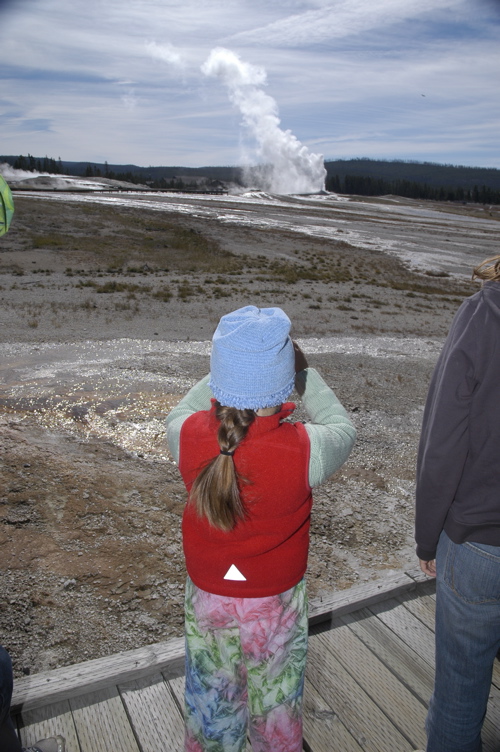 Somewhere in the campground were the folks we’d met in Cody, Yves and Marta. I unfolded the Birdy bike, put on all my warm clothes (long underwear, two shirts, windproof pants, heavy socks, fleece, jacket, hat, gloves) and rode around Madison campground to see if I could spot them.
Somewhere in the campground were the folks we’d met in Cody, Yves and Marta. I unfolded the Birdy bike, put on all my warm clothes (long underwear, two shirts, windproof pants, heavy socks, fleece, jacket, hat, gloves) and rode around Madison campground to see if I could spot them.
Riding in 27 degrees is really not bad if you’re dressed for it. It reminded me of many bike rides I had done in Massachusetts in the late fall when we lived there in the 1990s. I liked it enough that I took a few extra loops through the campground that weren’t strictly necessary, just for the pleasure of riding.
I might have had a chance to find Yves and Marta if I had a clue of their last name, the color of their tent, or the vehicle they were driving, but I had failed to get any of that information back in Cody. It looked like our chances of meeting up were slim to none.
Still, on the bike ride I did see the first of many bison, and off in the distance I heard an elk bugling. It was just too exciting to stay in the trailer much longer, so we woke Emma up and headed over to Old Faithful to attend a 10:30 ranger talk. Of course there I ran into Yves and Marta …
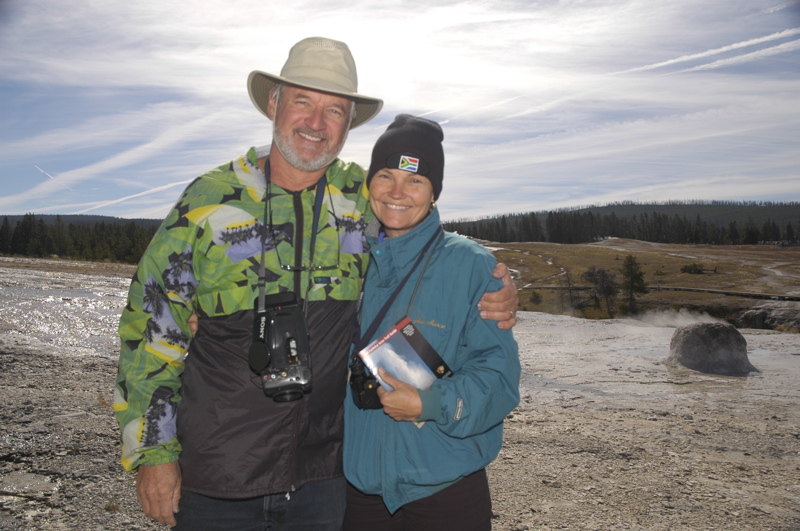
I have to admit that I was surprised to find them, since they were tenting in sub-freezing temperatures, but when I asked they exclaimed, “We couldn’t leave, not while the weather is so nice!” And it was nice with the sun shining on the geysers. We made plans to meet up in the evening.
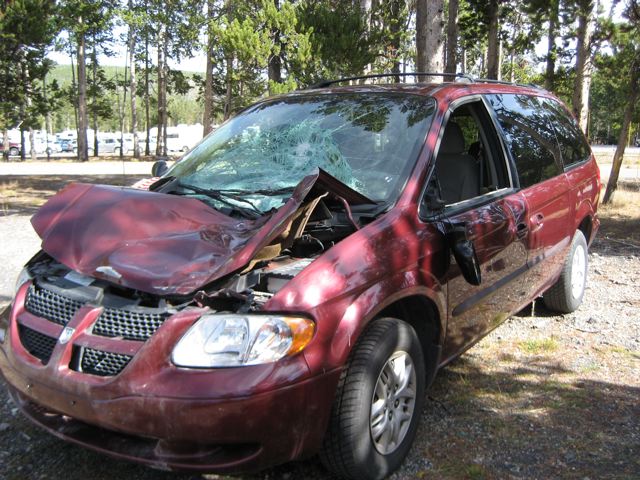
While at Old Faithful we found the car that hit the elk … a reminder that there’s a 45 MPH speed limit in the park for a very good reason.
 Emma quickly burned out on geysers, hot springs, and fumaroles, but Eleanor and I couldn’t get enough of them. I even like the sulphurous smell of the steam. The best ones are the deep boiling blue ponds that remind me of Florida springs, and the ones with orange thermophilic bacterial mats around the edges, like Grand Prismatic Spring.
Emma quickly burned out on geysers, hot springs, and fumaroles, but Eleanor and I couldn’t get enough of them. I even like the sulphurous smell of the steam. The best ones are the deep boiling blue ponds that remind me of Florida springs, and the ones with orange thermophilic bacterial mats around the edges, like Grand Prismatic Spring.
I’ll upload a pile of photos of geysers and other sights of Yellowstone to our Flickr photo album when I get a chance.
Of course Emma is working on a Junior Ranger badge while she is here. Last year she got the badge for the younger kids (identical to the older kids’ badge but following a different program), and this year she is working on the badge for the 8-12 year-olds. A minor disaster occurred along the way today, when a high wind blew a page of her booklet into a pool of boiling water. Needless to say, I didn’t jump in after it. Only in Yellowstone can such a disaster occur.
It was an important page, one which had been signed by a ranger earlier (to acknowledge that Emma had attended his talk). Fortunately, we were able to get a replacement page at the Old Faithful visitor center and found the ranger again for a replacement signature.
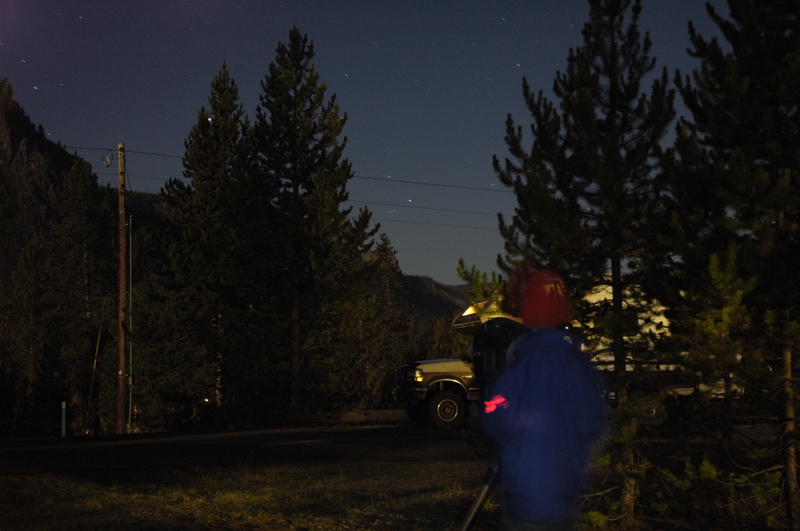 This evening Bert and Janie pulled in, towing their 28-foot Airstream. We introduced them to our neighbors, who had pulled out a large Meade telescope with computer control, and I tried some night photography while Jacob (the 10-year-old) worked with the scope.
This evening Bert and Janie pulled in, towing their 28-foot Airstream. We introduced them to our neighbors, who had pulled out a large Meade telescope with computer control, and I tried some night photography while Jacob (the 10-year-old) worked with the scope.
Around nine Marta and Yves showed up for a bit of late dessert and wine over our dinette. They turned out to be very interesting: Captain and Mate for hire on various boats, based in Cape Town South Africa, and now traveling the US for three months in their van and tent. I have no doubt that we will see them again in the next year, somewhere in the USA.
Our solar gain report for the day looked like this:
Clear skies. At 4 p.m. cumulative amp-hours were -28. 27 amp-hours gained.
So we gained more power than I had expected given the trees, but clearly my initial budget of 60 amp-hours per day needs revision if we are to last for five nights. The furnace is the problem, so tonight instead of setting the thermostat at 58, we’ll set it lower to 50 degrees. That’s actually fun, makes it feel more like camping.
« Previous entries ·
Next entries »
 This is the farthest we’ve ever taken this Airstream north ( 51 °11’0.62″N). In mid-October at this latitude, our solar panels still generate some power, but not nearly enough to compensate for the furnace. Nights are running in the low 30s and daytime highs are in the 50s, with the sun passing by at a very low angle. This is optimal weather for October but without a power hookup for the Airstream we’d still lose ground rapidly.
This is the farthest we’ve ever taken this Airstream north ( 51 °11’0.62″N). In mid-October at this latitude, our solar panels still generate some power, but not nearly enough to compensate for the furnace. Nights are running in the low 30s and daytime highs are in the 50s, with the sun passing by at a very low angle. This is optimal weather for October but without a power hookup for the Airstream we’d still lose ground rapidly. This time of year the options of “what to do” in Banff are more limited than in Summer. All of the campgrounds are closed except the one we’re in. The amphitheater talks are done for the season. Open hours are limited in many places, the “Ice Explorer” (a sort of giant bus than takes tourists over the glacier) stops running on the 15th, some roads and historic sites are closed, etc.
This time of year the options of “what to do” in Banff are more limited than in Summer. All of the campgrounds are closed except the one we’re in. The amphitheater talks are done for the season. Open hours are limited in many places, the “Ice Explorer” (a sort of giant bus than takes tourists over the glacier) stops running on the 15th, some roads and historic sites are closed, etc. You could easily spend a day just looking at the views. They are endless and constantly changing. Every street in town, every site in the campground, every minute of the day, has a different view ““ and they are all good.
You could easily spend a day just looking at the views. They are endless and constantly changing. Every street in town, every site in the campground, every minute of the day, has a different view ““ and they are all good.





















